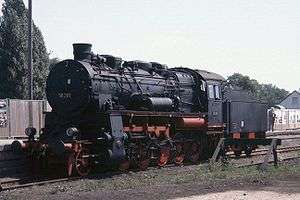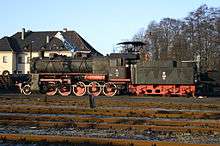Prussian G 12
| Prussia, Alsace-Lorraine, Baden, Württemberg G 12 Saxon XIII H (1919 version) DRG Class 58.2–5/10–21 ÖBB Class 658 PKP Class Ty1 SNCF 150 C | |
|---|---|
 | |
| Number(s) | DRG 58 201–225, 231–272, 281–303, 311–318, 401–462, 501–543, 1002–2148 |
| Quantity | 1,478 |
| Manufacturer | Henschel and others |
| Year(s) of manufacture | 1917–1924 |
| Retired | 1976 |
| Axle arrangement | 1'E h3 |
| Type | G 56.17 |
| Gauge | 1,435 mm (4 ft 8 1⁄2 in) |
| Length over buffers | 18,495 mm (60 ft 8.1 in) |
| Service weight | 95.7 t |
| Adhesive weight | 82.5 t |
| Axle load | 16.7 t |
| Top speed | 65 km/h (40 mph) |
| Indicated Power | 1,133 kW |
| Driving wheel diameter | 1,400 mm (4 ft 7 in) |
| Leading wheel diameter | 1,000 mm (39 in) |
| Cylinder bore | 570 mm (22 in) |
| Piston stroke | 660 mm (26 in) |
| Boiler Overpressure | 14 bar |
| Grate area | 3.88 m2 (41.8 sq ft) |
| Superheater area | 68.42 m2 (736.5 sq ft) |
| Evaporative heating area | 192.43 m2 (2,071.3 sq ft) |
| Tender | Prussian 3 T 20, Prussian 2'2' T 31,5, Saxon 3 T 21 |
| Water capacity | 20.0/21.0/31.5 m³ |
The Prussian G 12 was a 2-10-0 goods train locomotive with the Prussian state railways (Preußische Staatseisenbahnen).
It was built because it had been shown during the First World War that it was a great disadvantage, from a servicing and maintenance point of view, for each state railway to have its own locomotive classes with no standardization. In addition, the military railways needed a fast, powerful, goods train locomotive, that did not, however, have a high axle load.
Design
The G 12 was based on the Prussian G 12.1 and a 2-10-0 locomotive built for the Imperial Ottoman Department for Military Railways (Kaiserlich Ottomanische Generaldirektion der Militäreisenbahnen or C.F.O.A.) by Henschel (see Prussian G 12 (C.F.O.A)).
The locomotives differed in several points from earlier principles for Prussian locomotive design. Firstly they had a continuous bar frame and a wide, outer, Belpaire firebox located above the frame with a large grate area.
Construction
Between August 1917 and 1921, a total of 1,168 G 12s were procured by Prussia. The Imperial Railways in Alsace-Lorraine ordered 118, the Grand Duchy of Baden State Railway 88, the Royal Saxon State Railways 42 and the Royal Württemberg State Railways 42 engines. In addition, Baden bought 10 locomotives from the Prussian state railways. Even the Deutsche Reichsbahn receive a batch of 20 locomotives in 1924 that, following the Saxon XIII H, were given the numbers 58 443-462.
The Saxon locomotives were, like their predecessors, designated as Class XIII H; Baden and Württemberg took on the Prussian designation of G 12. Only the Bavarian State Railways, the railways of Mecklenburg and Oldenburg did not buy any G 12s; as a result the G 12 can be viewed as the precursor to the standard locomotives or Einheitsloks in Germany.
Deutsche Reichsbahn
The majority of locomotives of this class were taken over by the Deutsche Reichsbahn. There they were given the following operating numbers:
- Baden G 12: 58 201–225, 231–272, 281–303, 311–318
- Saxon XIII H: 58 401–462
- Württemberg G 12: 58 501–543
- Prussian G 12: 58 1002–2148.
Number 58 1001 was not a G 12, rather an engine for the C.F.O.A. left in Germany.
Coal dust firing
Around 1930, six engines were converted to coal dust firing and, after 1945, a number of other engines followed suit, of which 43 remained in service for a long time (up to 1968).
World War II

In World War II, 58 2144 from Poland and 58 2145-2148 from Luxembourg were incorporated.
The Deutsche Bundesbahn retired their units in 1953. The East German Deutsche Reichsbahn still had 300 machines in service in 1968. On the introduction of EDP numbers in 1970, a '1' was usually prefixed to three-digit operating numbers. The last locomotives were mustered out in 1976. 56 locomotives were converted by the Deutsche Reichsbahn to Class 58.30 Rekoloks between 1958 and 1962.
After World War II, locomotives 58 1669, 1746, 1767, 1904, 1917, 2122 and 2132 remained on Austrian national territory. Number 58 1669 was given back to the DB in 1949, 58 1904 was paid off in 1951 and 58 1917 ended up in the Soviet Union in 1949. The remaining four engines formed the Austrian ÖBB Class 658. All the engines were retired by 1966. However at least two examples (658.1746) and (658.2122) survived longer in use as a heating locomotive at Linz depot. 658.1746 was seen dumped as 01033 in August 1972 along with 658.2122 as 01042. 01042 survived until at least February 1976.
The locomotives remaining in Poland after 1945 were given the PKP class Ty1. Those in Yugoslavia became class 36.
Tenders

The G 12 was mainly equipped with Prussian class 3 T 20 or 2'2' T 31.5 tenders. The Saxon XIII H, on the other hand, generally ran with the somewhat larger Saxon class 3 T 21 tenders, resulting in a greater overall length. Because water tank volume was reduced on conversion to coal dust firing, only large Prussian 2'2' T 31.5 tenders or standard tenders were used after the war.
Preservation
Today, two former Baden locomotives of the older type, 58 261 (Bw Chemnitz-Hilbersdorf) and 58 311 (Ettlingen), and a Prussian original, 58 1616 (formerly used as a steam generator (Dampfspender) (Bw Hermeskeil), remain preserved. See the List of preserved steam locomotives in Germany.
See also
| Wikimedia Commons has media related to Prussian G 12. |